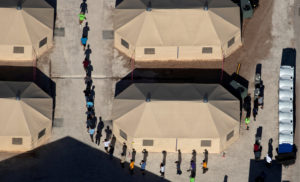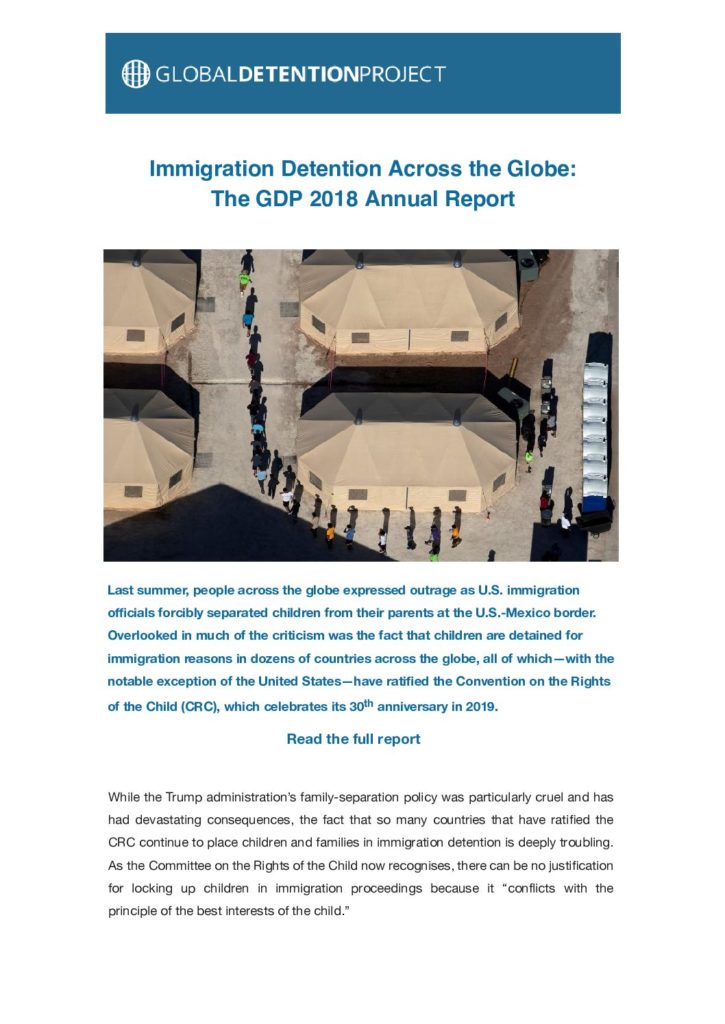Last summer, people across the globe expressed outrage as U.S. immigration officials forcibly separated children from their parents at the U.S.-Mexico border. Overlooked in much of the criticism was the fact that children are detained for immigration reasons in dozens of countries across the globe, all of which—with the notable exception of the United States—have ratified the Convention on the Rights of the Child (CRC), which celebrates its 30th anniversary in 2019.
While the Trump administration’s family-separation policy was particularly cruel and has had devastating consequences, the fact that so many countries that have ratified the CRC continue to place children and families in immigration detention is deeply troubling. As the Committee on the Rights of the Child now recognises, there can be no justification for locking up children in immigration proceedings because it “conflicts with the principle of the best interests of the child.”
Child detention policies often seem bizarre or banally callous because they employ misleading language that masks the threat they pose to children. For instance, in Canada children are “housed” as “guests” of their parents in immigration detention. In France, Poland, Spain, and numerous other countries children “accompany” their parents in detention centres. Such policies make detained children “invisible” to the law, preventing them from accessing legal protections that are offered to other detainees—including hardened criminals—while denying them education, healthcare, and nurturing environments.
The continued insistence by states that immigration enforcement decisions take precedence over considerations of the well being of children is reflected in the much-anticipated Global Compact for Migration (GCM), adopted last December. As we discuss in this Annual Report, there is much that is laudable in the GCM, including its insistence that detention only be used as a measure of last resort.
Concerning children, while the GCM encourages states “to end the practice of child detention,” it falls short of recognising immigration detention’s violation of the “best interest” principle or calling for the prohibition of child detention. Instead, it calls on states to apply “alternatives to detention.” However, as a growing number of observers now recognise, while “alternatives” may have a rationale in the context of adults, their application to children is contradictory and perilous. If the immigration detention of children is fundamentally at odds with their best interests, then “alternatives” likewise should not apply since by definition they form part of detention procedures. In effect, encouraging states to consider “alternatives” for children may reinforce the policy of detaining them. This is a quandary that we must not ignore.
Herein lies the crux of the dilemma of immigration detention: As long as states insist that their sovereign rights trump the individual rights of non-citizens, any seeming “solution” to detention that does not explicitly and unambiguously define a path to diminishing the practice may ultimately lead to its persistence and growth.
We at the Global Detention Project do not pretend to have all the answers to this dilemma. But we hold in high esteem those who tirelessly—and self-critically—seek ways to prevent abuses in detention and to challenge its attraction to authorities. This can often seem a thankless struggle. With each new “crisis,” any gains that had been made can easily be erased. What is more, some achievements (like improving the conditions of detention) can appear in hindsight plagued with unintended consequences (such as increased detention).
“As long as states insist that their sovereign rights trump the individual rights of non-citizens, any seeming “solution” to detention that does not explicitly and unambiguously define a path to diminishing the practice may ultimately lead to its persistence and growth.”
How do you measure success when things seem to be getting worse? It is a question that human rights organisations often face. One way to respond is by asking a counterfactual: What would the world look like if we were not there pushing back? That is a legitimate question. But it lacks concrete detail, and thus may seem compelling to few.
In our Annual Report, we discuss many concrete examples of how the work of the GDP over the past year has had an impact. We discuss, for instance, the growing use of the GDP’s online database the Global Immigration Detention Observatory, and the role it has played in calls for change. We highlight how UN human rights mechanisms have made calls to action reflecting our recommendations while media outlets across the globe are making increasing use of our data to draw attention to the plight of detainees. We feature cases where the GDP website has helped connect families with detainees. And we reflect on how our interactions with academics, NGOs, government officials, and international organisations have helped build new consensus on reforming detention institutions.
With support from our key institutional partners—including the Oak Foundation, the Open Society Foundation, and the Human Security Division of the Swiss Federal Department of Foreign Affairs—we look forward to building on these efforts while continuing our work to ensure that vulnerable migrants, refugees, and asylum seekers are treated with respect and dignity.
Michael Flynn (Executive Director) and Roberta Cecchetti (President)




